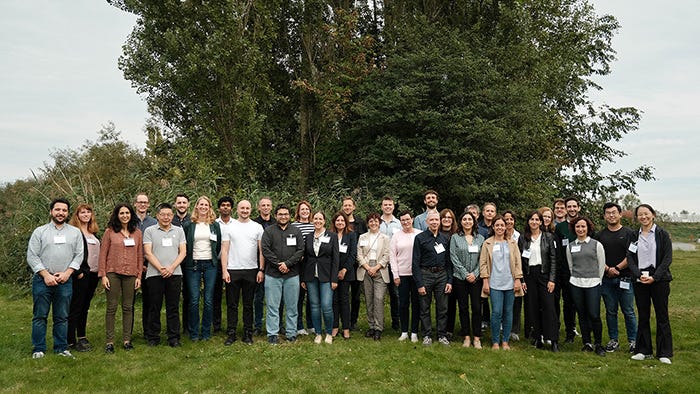Biopolymer from Wastewater Emissions
A European consortium to harness the carbon dioxide produced during wastewater treatment for production of bio-based PLGA.

A consortium of 12 European partners has launched a four-year research project to transform wastewater into bio-based polymers for packaging applications. The group’s acronym, HICCUPS, is short for ‘highly innovative technology demonstration for bio-based carbon dioxide capture and utilization for production of bulk plastics applications.’
The project’s mission is to develop an efficient method for electrochemically converting carbon dioxide emissions from water-treatment sludge into poly lactic-co-glycolic acid (PLGA). The project’s final products will include PLGA-coated paper for food packaging, and molded plastic.
PLGA, a biodegradable polymer made from renewable feedstock, offers excellent water and gas barriers and is an environmentally friendly alternative to the fossil-based polymers commonly used in packaging.
The HICCUPS project launched in September 2023 and will continue through August 2027. It received a grant of €5 million/$5.44 from Horizon Europe, a European Union research-and-innovation funding program.
HICCUPS includes partners with expertise across the value chain, from biogenic carbon dioxide capture to packaging materials production. The partners include corporations, universities, and technology research centers in seven countries: Spain, France, Germany, Norway, the Netherlands, Finland, and Italy.
Consortium members include Spain’s Acciona, Funditec, and Tecnopackaging; Norway’s Aqualung Carbon Capture and SINTEF; Italy’s University of Ferrara; and Finland’s Walki. Avantium Chemicals, based in the Netherlands, is the HICCUPS project coordinator.
Incorporating the entire value chain in the project, particularly the conversion of biopolymers into consumer goods packaging, sets the project apart from others focusing on wastewater. One such project in Argentina, which ceased operation in 2018, aimed to use duckweed grown in wastewater as biomass for biorefining.

Group picture of the HICCUPS consortium taken in Amsterdam. Credit: Eric Schuler, Avantium
Multistep process delivers bio-based packaging.
The first step of HICCUPS targets infrastructure, with the construction of a demonstration plant at a wastewater treatment facility. “During the second year of the [HICCUPS] project, our project partner Aqualung will install a CO2-capture demo plant at Acciona’s wastewater treatment facility in Spain,” says Robert-Jan van Putten, program manager/senior scientist corporate technology, Avantium.
The goal is to scale up technology that worked in the lab to a demonstration/piloting scale of about 100 kg/220 pounds.
“If we are successful with this, then from a technological perspective, a realistic timeframe is to complete piloting before 2030,” van Putten adds.
At the demonstration plant, Aqualung, SINTEF, and Funditec will be responsible for capturing and purifying the carbon dioxide in biogas produced during wastewater treatment. Aqualung’s highly efficient, proprietary membrane technology will separate carbon dioxide from the biogas produced by anaerobic digestion of sludge.
“The captured CO2 will be shipped to Avantium and converted into PLGA. This new CO2-based polymer will then be tested within the project in different packaging applications,” van Putten explains.
Avantium, using its Volta Technology, will electrochemically convert the carbon dioxide into oxalic acid and then reduce that product to glycolic acid. The company will then polymerize the glycolic acid into PLGA.
Barrier packaging materials from pilot plants.
Walki and Tecnopackaging will use their industrial pilot plants to produce packaging materials from Avantium’s PLGA, testing the material for liquid and gas barrier properties and other characteristics.
Walki will conduct extrusion and wet-coating trials with fiber substrates, producing coated paper and board samples. Additionally, researchers at the University of Ferrara will perform processability tests to identify optimal conditions for coating paper with PLGA.
Several other studies will be part of the project, to demonstrate the potential of the HICCUPS technology for packaging. These will include life cycle analyses, biodegradability and recycling research, digital projections, and a business case analysis performed by institutions such as the University of Amsterdam; France’s National Research Institute for Agriculture, Food and the Environment (INRAE); and Germany’s nova-Institute.
In a project previous to HICCUPS, “Avantium took part in the OCEAN project, which looked at similar technology and the same polymer family.… The main difference is that the HICCUPS project has the purpose of making the next step towards application,” says van Putten.
From a business standpoint, Avantium is seeing a “very high interest level in the materials we are working on within the [HICCUPS] project, because of their excellent barrier properties — very important in food, pharmaceutical, and cosmetics packaging — recycling potential, and marine biodegradability,” he adds. However, “this interest level will only remain if the materials can be produced at a price point that is low enough to be realistically considered for bulk application.”
The HICCUPS project is funded by the European Union. Views and opinions expressed are those of the author(s) only and do not necessarily reflect those of the European Union or the Circular Bio-Based Europe Joint Undertaking. Neither the European Union nor the CBE JU can be held responsible for them.
About the Author(s)
You May Also Like




